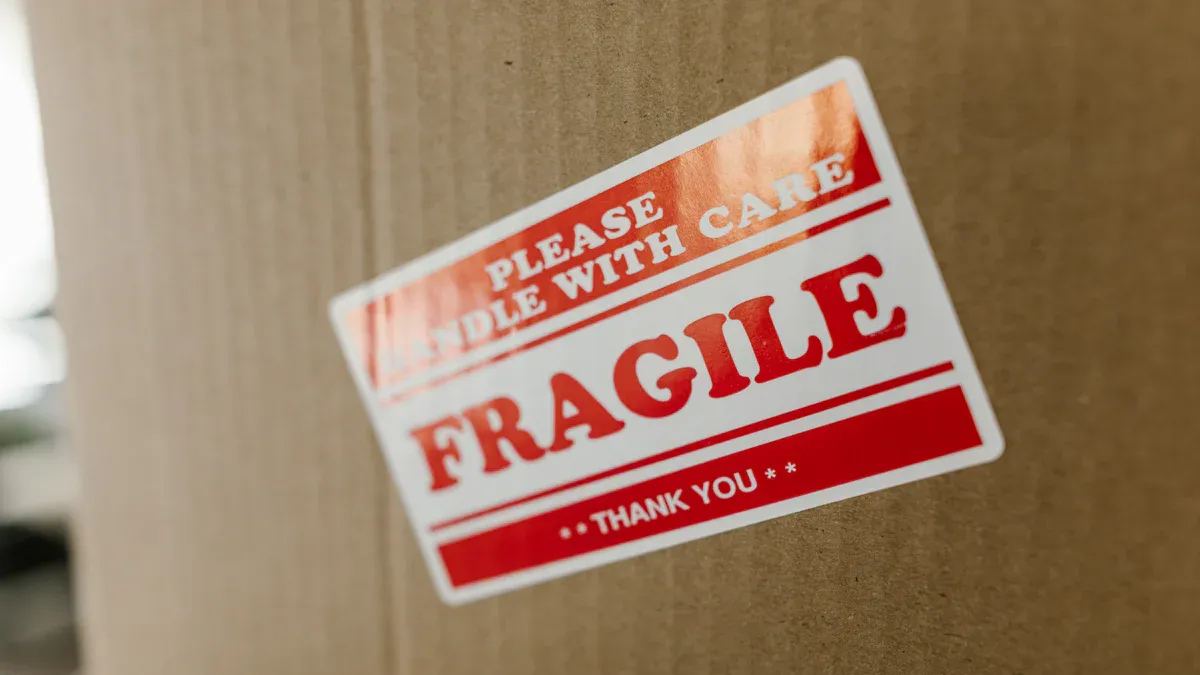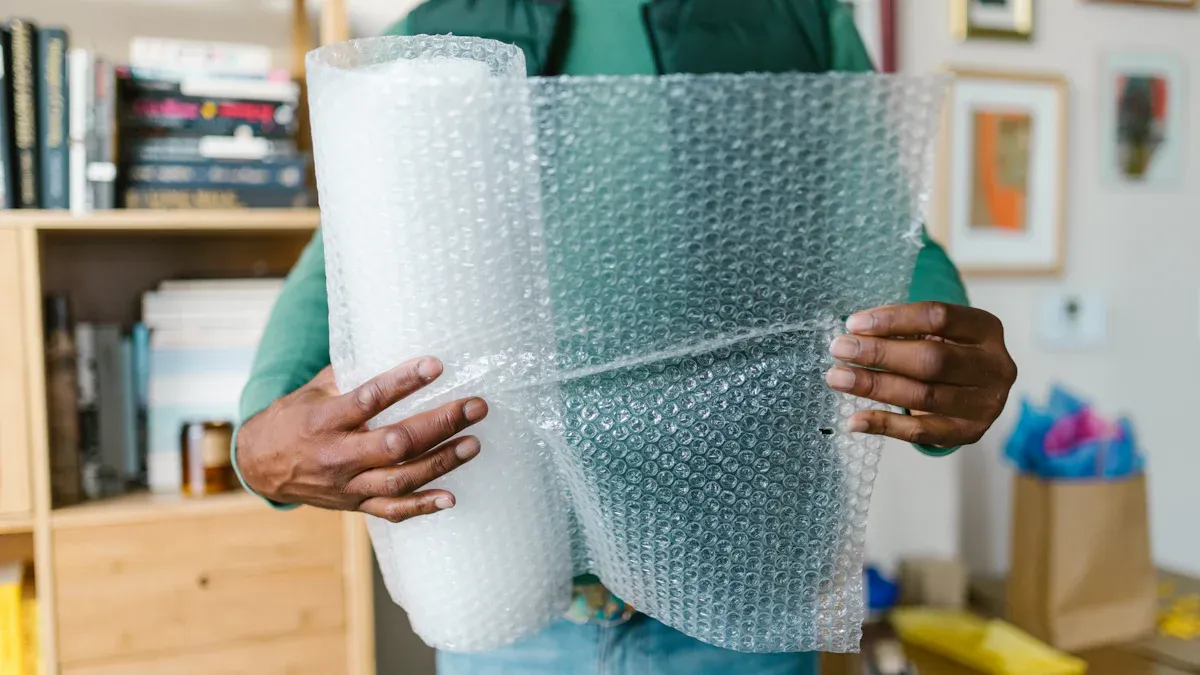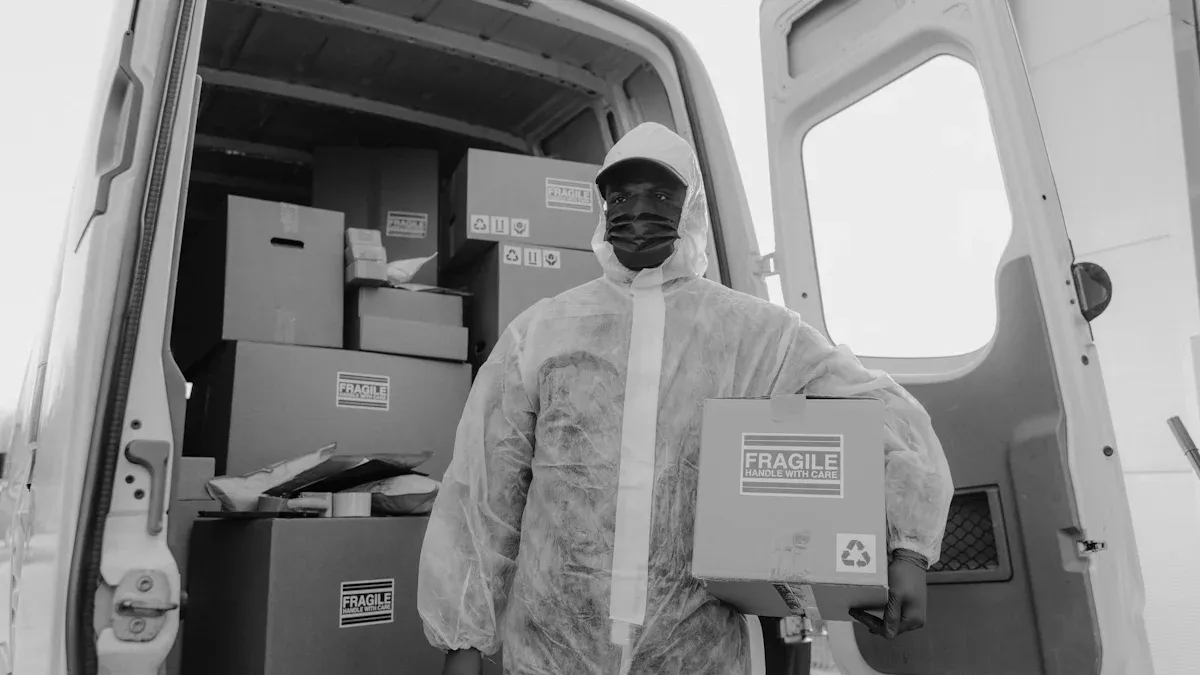How to Safely Transport Fragile Items Without Damage

You want your fragile items to arrive safely, right? The truth is, about 11% of all goods reach their destination with damage, so extra care matters. To prevent accidents, you should:
Wrap each item with soft materials.
Use sturdy boxes and secure them with reinforced tape.
Label boxes as 'fragile' and fill gaps to stop movement.
Here are mistakes many people make:
Mistake | Explanation |
|---|---|
Inadequate Cushioning | Not enough padding lets items break easily. |
Wrong Box Size | Oversized or tight boxes cause shifting or pressure. |
Poor-Quality Packaging | Flimsy materials do not protect during fragile item transportation logistics. |
Anyone can master this process with a little planning and patience!
Key Takeaways
Wrap each fragile item with soft materials like bubble wrap and packing paper to absorb shocks and prevent scratches.
Use sturdy boxes that are 10–25% larger than your items, ensuring enough space for cushioning to keep everything secure.
Label all boxes clearly as 'Fragile' to alert handlers and reduce the risk of mishandling during transport.
Fill empty spaces in boxes with crumpled paper or foam to prevent movement, which is a common cause of damage.
Double-check your packing by gently shaking each box. If you hear movement, add more padding to keep items snug.
Essential Steps
Plan & Organize
You want to start with a solid plan before you even touch a box. Good organization makes everything easier and safer for your fragile items. Here’s how you can set yourself up for success:
Take inventory room by room. Walk through your home and list every fragile item. This helps you gather the right supplies and keeps you from forgetting anything important.
Gather quality packing materials. Invest in sturdy boxes, bubble wrap, and packing paper. Using the right supplies means your items have a much better chance of arriving in one piece.
Sort and group similar items. Keep glassware, ceramics, and electronics together. This makes packing more efficient and helps you choose the best protection for each group.
Create layers of protection. Think of packing like building a cocoon. Use multiple layers of soft materials to cushion your valuables.
Check your insurance. Sometimes, accidents happen. Make sure you have coverage for your most valuable or sentimental items.
Learn from the pros. Packing fragile items well takes a mix of experience, good technique, and the right tools. Don’t be afraid to ask for advice or watch a quick tutorial.
Tip: Distinguish between packing tips that actually work and those that might put your valuables at risk. Not every hack you see online is a good idea!
Handle With Care
Now that you’ve planned, it’s time to get hands-on. How you handle your fragile items makes a huge difference. Even the best packing job can’t save an item from rough treatment.
Identify fragile items first. Mark them so you remember to give them extra attention.
Wrap and secure each item individually. Don’t just toss things together. Use packing paper and bubble wrap, layering soft materials between items to absorb shocks.
Pack glass vertically. Place glassware and plates on their sides, not flat. This reduces pressure and lowers the risk of cracks.
Use enough cushioning. Line the bottom of each box with at least two inches of crumpled paper or bubble wrap. If you shake the box and hear movement, add more padding.
Place heavier items at the bottom. Stack lighter, more delicate pieces on top. This keeps everything stable and prevents crushing.
Handle with gentle care. When loading and unloading, use both hands and move slowly. Tools like hand trucks can help you avoid drops or bumps.
Double-check before sealing. Give each box a gentle shake. If anything shifts, add more cushioning until everything feels snug.
Note: Most breakage happens because of poor packing or rough handling. Take your time and treat every item like it’s irreplaceable.
Packing fragile items doesn’t have to be stressful. With a little planning and careful handling, you can keep your treasures safe from start to finish.
Packing Materials

Bubble Wrap & Packing Paper
You want your fragile items to stay safe, so choosing the right packing materials matters. Bubble wrap and packing paper work best when you use them together. Bubble wrap gives you excellent shock absorption and keeps moisture away. Packing paper protects surfaces from scratches and is more eco-friendly. Here’s how they compare:
Bubble wrap cushions valuables and prevents breakage during transport.
Packing paper wraps fragile items and shields them from surface damage.
Using both together means better protection for your breakables.
Tip: Wrap each item with packing paper first, then add a layer of bubble wrap. This combo keeps your items safe from bumps and scratches.
Sturdy Boxes & Cushioning
You need strong boxes and plenty of padding to keep fragile items secure. Experts recommend boxes that are 10–25% larger than your items. This gives you enough space for cushioning. Always use sturdy, corrugated cardboard boxes. Thicker boxes work better for heavier or larger items. Check out these recommendations:
Recommendation | Details |
|---|---|
Box Size | |
Box Type | Sturdy, corrugated cardboard |
Cushioning | At least 3 inches of padding around each item |
Padding | Enough to prevent shifting and absorb impacts |
Double-boxing works great for high-value or delicate items. Place your wrapped item in a smaller box with cushioning, then put that box inside a larger box with more padding. This method gives you two layers of protection.
Note: Always wrap items individually and use air-cellular cushioning to keep everything snug and secure.
Eco-Friendly Choices
You can protect your fragile items and help the planet at the same time. Eco-friendly packing materials offer strong protection and are easy to recycle. Here are some top choices:
Packing Material | Benefits | Best For |
|---|---|---|
Corrugated Inserts | Durable, custom fit, fully recyclable | Multi-piece shipments needing separation |
Honeycomb Kraft Paper | Biodegradable, plastic-free, strong cushioning | Wrapping irregular shapes or single items |
Tissue Paper | Lightweight, recyclable, prevents surface damage | Scratch-sensitive items or as a first layer |
Kraft paper stands out because it’s compostable and has a recycling rate of up to 95%. You can use it for wrapping or as extra padding.
Tip: Choose eco-friendly options when possible. You’ll keep your items safe and reduce waste at the same time.
Packing Techniques
Glass & Ceramics
Packing glass and ceramics takes patience. Start by cleaning each piece with a soft, damp cloth. Wrap every item in bubble wrap and secure it with tape. Use corrugated cardboard sheets as dividers between items. Stack plates vertically with cardboard in between, and nest mugs with padding. Always line the bottom of your box with crumpled packing paper or foam. Place heavier items at the bottom and fill gaps to prevent movement. Label boxes with "Fragile" and "This Side Up" stickers. This helps with fragile item transportation logistics and keeps your breakables safe.
Electronics
Electronics need extra care. Back up your data before packing. Take photos of cable setups so you can reconnect everything later. Power down devices and remove batteries. Wrap each device in anti-static material. Use double-walled boxes and add spacers or air pillows for shock absorption. Place electronics in a larger box with plenty of cushioning. Separate batteries and cover terminals. Label boxes as fragile and note if they contain lithium-ion batteries. These steps help with fragile item transportation logistics, especially if you ship electronics or travel by air.
Artwork & Frames
Artwork and frames can crack or scratch easily. Pack pictures on their side, not flat. Use cardboard corners and bubble wrap for protection. Secure everything with tape. Label frames as "Fragile" so movers know to handle them gently. If you use postal bags or travel by air, ask for a fragile tag. This alerts handlers to take extra care.
Furniture
Furniture needs special attention. Clean surfaces before packing. Disassemble bulky pieces and wrap each part. Use moving blankets and secure them with tape or stretch wrap. Bubble wrap works best for glass tabletops and mirrors. Protect corners with pads or extra blankets. Seal wrapped furniture with plastic wrap to keep out moisture and dust. Load heavy items at the bottom of the truck and use straps to prevent shifting. These steps make fragile item transportation logistics much smoother.
Tip: Always fill empty spaces with packing paper or soft filler. This stops items from moving and keeps everything safe.
Fragile Item Transportation Logistics

Getting your fragile items from point A to point B takes more than just good packing. You need smart logistics to keep everything safe. Let’s break down the steps you should follow for smooth and secure fragile item transportation logistics.
Labeling & Weight Distribution
You want everyone who handles your packages to know they need extra care. Clear labeling makes a huge difference. When you use "Fragile" stickers or write "Handle With Care" on your boxes, you help reduce mishandling. Handlers pay more attention, sorting facilities give your items special treatment, and everyone knows to be careful. Here’s what works best:
Fragile labels tell handlers to slow down and avoid tossing your box.
Clear instructions on the label lower the risk of accidental damage.
Visible labels make people more accountable for careful transport.
Weight distribution matters just as much. If you pack all the heavy stuff on one side, you risk tipping, crushing, or even causing accidents. Spread the weight evenly in each box and across your vehicle. Place heavier items in the center of your car or truck to balance the load. This keeps your fragile item transportation logistics safe and steady. Balanced boxes are easier to carry and less likely to break open.
Tip: Always check the weight before you lift. If a box feels lopsided, rearrange the contents so it sits flat and stable.
Preventing Movement
Movement inside boxes is the enemy of fragile items. You want everything to stay put during the journey. Start by picking a box that fits your item closely. Too much empty space lets things slide around. Fill gaps with bubble wrap, foam rolls, or crumpled paper. Wrap each item on its own, and use cardboard sheets between stacked pieces to stop rubbing.
Here’s a quick checklist for preventing movement:
Choose boxes that fit your items snugly.
Add extra padding around every item.
Fill empty spaces with foam peanuts, towels, or paper.
Place cardboard sheets between items to prevent contact.
If you’re shipping something extra delicate, double-box it. Put your item in a small box with padding, then place that box inside a bigger one with more cushioning. This method gives you two layers of defense against bumps and drops.
Note: Most damage during fragile item transportation logistics happens because items shift or collide inside the box. Take your time and make sure everything is packed tight.
Final Checks
Before you seal up your boxes, do a final check. Gently shake each box. If you feel or hear anything moving, add more padding. This simple shake test helps you catch problems before they become disasters. For super fragile shipments, you can try a drop test from a short height or a vibration test to see if your packing holds up.
Here’s a table to help you remember your final checks:
Step | What to Do | Why It Matters |
|---|---|---|
Shake Test | Gently shake the box for movement | Finds loose items before transit |
Add Padding | Fill gaps if you hear shifting | Stops items from colliding |
Label Clearly | Use "Fragile" and "This Side Up" stickers | Alerts handlers to take care |
Drop Test | Drop box from 80–100cm on all sides (optional) | Checks for packing strength |
Vibration Test | Simulate transport for 60–120 minutes (optional) | Tests for long-distance safety |
Don’t forget about the bigger picture. Choose the safest route for your shipment. Work with logistics companies that care about safety and efficiency. Give clear instructions to keep packages upright and away from extreme temperatures. Research your shipping partners, read reviews, and ask for recommendations. Use insurance and tracking for peace of mind.
Tip: If you’re mailing or flying with fragile items, ask for special handling services. USPS and UPS offer "Special Handling-Fragile" stickers. While these don’t guarantee protection, they help you get support if something goes wrong.
Common causes of damage include poor packaging, rough handling, bad stacking, and road hazards. You can avoid most problems by packing well, labeling clearly, and choosing reliable carriers. Fragile item transportation logistics is all about planning, attention to detail, and double-checking every step.
You’ve got this! With smart logistics and careful packing, your fragile items will arrive safe and sound.
You can keep your fragile items safe by following a few simple steps:
Clean and dry each item before packing.
Disassemble and secure loose parts with soft padding.
Wrap every piece with bubble wrap and packing paper.
Fill hollow items and empty spaces for extra support.
Use sturdy boxes and reinforce with tape.
Label boxes clearly as "Fragile".
Take your time and double-check each box. Careful packing gives you peace of mind and helps your treasures arrive safely. You’ve got this! 😊
FAQ
How do you choose the best box for fragile items?
Pick a box that is 10–25% bigger than your item. Make sure the box is sturdy and has thick walls. You want enough space for padding on all sides.
Can you reuse old packing materials?
You can reuse clean bubble wrap and sturdy boxes. Check for tears or weak spots. If you see damage, use new materials to keep your items safe.
What should you do if you run out of bubble wrap?
Grab towels, socks, or crumpled paper. These work as quick padding. Wrap each item tightly. Fill empty spaces so nothing moves inside the box.
Is it safe to ship fragile items by mail?
Yes, you can ship fragile items by mail. Use strong boxes, lots of padding, and clear "Fragile" labels. Ask for special handling at the post office for extra care.
See Also
Count On PGL For Safe HAZMAT Freight Solutions
Key LCL Shipping Guidelines For Panama Exports By PGL
PGL Offers Reliable Refrigerated Transport For Perishables
Dependable Cold Chain Storage Solutions By PGL On East Coast
